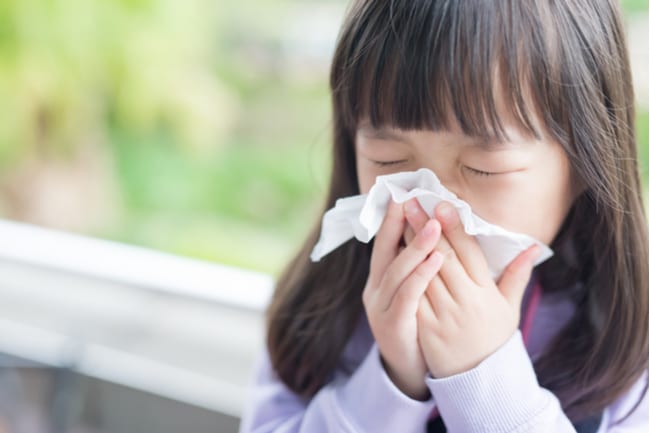Allergies in children occur when the child’s immune system reacts to substances that are harmless to most children. Some substances are known allergens, which means they are known to cause allergic reactions in children and others susceptible to allergies. These substances include dust mites, pets, pollen, insects, ticks, mold, various foods, and some medications.
Allergies can make a child feel miserable with chronic uncomfortable symptoms. For some children, however, allergies don’t just affect quality of life, but are so severe as to be life-threatening. Any child can develop an allergy, but allergies are more common in children whose families have them, too.
A child who often coughs or sneezes, develops rashes or hives, or gets stomach aches, cramps or nausea each time he or she eats a certain food, may be experiencing allergies. If you identify those allergies early on, you have a good chance of making your child’s life a better, more comfortable one. By identifying and dealing with a childhood allergy, you’ll cut down the number of days your child will have to miss school. Treating the allergy means you’ll also be able to use your sick days and vacation days as they were intended, instead of using them to care for a sick child.

Allergies: Common Symptoms
In order to identify allergy symptoms in your child, you have to know what they might look like. Here are some of the most common symptoms associated with childhood allergies
- Skin rashes (such as atopic dermatitis or eczema)
- Hives
- Difficulty breathing (asthma)
- Sneezing
- Coughing
- Runny nose
- Itchy eyes
- Red eyes
- Stomach ache
- Stomach cramps
- Nausea
Common Allergens
Getting control over childhood allergies means avoiding the substances that trigger allergic reactions in children. Here is a list of the most common childhood allergens.
Out of doors:
- Tree pollen
- Plant pollen
- Insect bites
- Insect stings
Indoors:
- Pet hair or fur
- Animal dander
- Dust mites
- Mold
Irritants:
- Cigarette smoke
- Perfumes and scented products
- Automobile exhaust fumes
Foods that may be allergens:
- Peanuts
- Nuts
- Eggs
- Milk
- Dairy products
If you think your child may have an allergy, have the child seen by an allergist. In the days leading up to your appointment, keep a journal of your child’s symptoms and what substances you think might have caused them.
Common Allergy Issues
If your child has allergies, he or she is probably dealing with some of the following issues:
Allergic rhinitis, also known as hay fever, is the most common allergic condition in children. The symptoms of allergic rhinitis include runny, itchy nose; sneezing; postnasal drip; and nasal congestion or blockage. Other symptoms of hay fever include watery, red, itchy eyes, and fluid in the ears, which leads to ear pain, and ear infections. Hay fever is not triggered by hay, and does not come with fever.
Nasal congestion or a stuffy nose in children, is most commonly caused by allergies. When the nose is congested, a child is forced to breathe through the mouth. This can make for a restless night’s sleep, leaving your child tired during the day. This makes it difficult for children to concentrate in school. It’s important to note that if this congestion is not treated, it can affect the development of the child’s teeth as well as the bone structure of the face. Seek treatment for allergic nasal congestion as soon as possible, to prevent such issues.
Ear infections can develop when allergic congestion, causes fluid to accumulate in the ears. A buildup of fluid can lead to inflammation, pain, and a reduction in hearing. Decreased hearing puts babies and small children still learning to speak at risk for speech issues. Ear troubles due to allergies can cause ear pain, itching, popping, and a feeling of fullness or being “stopped up.” A child with ear trouble may rub or tug on her ear and may cry at night.
Food allergies affect some 6 million children in the United States. Breastfeeding is an excellent way to prevent food allergies for some children. But some children are so sensitive that they have allergic reactions to foods their breastfeeding moms eat. If you have allergies in your family, you may want to stay away from allergic foods while breastfeeding. You may also want to avoid introducing these foods to young children. Allergic foods include:
- Peanuts
- Milk
- Tree nuts (for instance, walnuts and cashews)
- Fish
- Shellfish
- Eggs
- Wheat
Peanuts and milk are the most common food allergens in children. The most severe childhood allergic reactions to food are generally to peanuts, tree nuts, fish, and shellfish. While not all children outgrow food allergies, they often outgrow their childhood allergies to milk, eggs, wheat, and soy.
Children with food allergies are at risk for anaphylaxis, a life-threatening allergic reaction that can cause breathing difficulties accompanied by a sudden drop in blood pressure. An anaphylactic reaction can send the body into shock. For this reason, doctors prescribe epinephrine, a form of adrenaline, that can be self-injected at the first symptom. The child’s school should be made aware of the condition and teachers trained in the use of administering the life-saving epinephrine in case of emergency.

Allergies: School Issues
Inform the school. If your child has allergies, his school should be informed. The same is true of summer camp or anywhere your child spends time. It’s important to ensure that the school knows what to do in case of emergency, and how to administer your child’s medications.
Classroom pets. Some classrooms have pets with fur, for instance gerbils, that can cause symptoms in children with allergies. If your child feels unwell in the classroom, for example, asthma, coughing, or congestion, a runny nose, a rash, or sneezing, such symptoms may well be caused by the classroom pet.

Asthma and gym class. Participating in sports or physical education classes is good for children, even those with asthma. Children with asthma should, however, take care to use their asthma medication regularly and as directed by a physician. When asthma symptoms occur during hard exercise or sports, it suggests that the child’s asthma is under poor control.
Chalk dust irritation. Chalk dust can be an irritant for those with allergies. Children with allergies may need to sit farther away from the blackboard to avoid irritation and allergy symptoms.
It’s a challenge to deal with children’s allergies, and it takes commitment. But take heart: so many children suffer from allergies that you are surely not alone in dealing with this issue!
If you suspect your child has allergies, don’t take a wait and see attitude, because early identification and treatment of allergies is crucial for your child’s health and development. See your child’s doctor as soon as possible.
